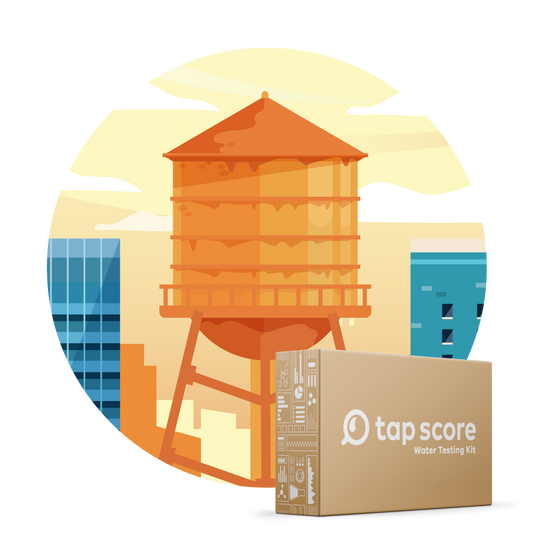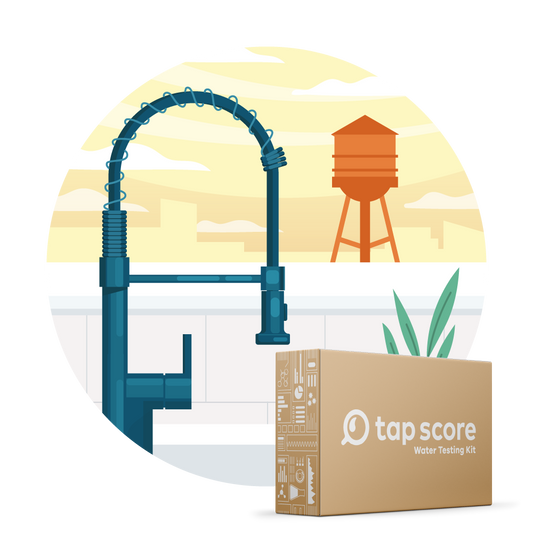
Lab Tests vs. Test Strips—What’s The Best Water Test For You in 2024?
Water quality is a growing concern among Americans nationwide. You might be wondering what you can do to be sure your drinking water is safe. The best way to learn about what’s flowing out of your tap and how it might impact your health is to buy a water test.
You can also read Why People Test Their Water to learn more about what to look out for.
With so many water test options available though, making the right decision can be a daunting task. In this crash course we’ll be covering:
-
The two most popular water test types: at-home strips and lab test kits
- The difference between at-home strips and lab test kits
- When to use at-home testing strips
- When to use lab test kits
- 5 tips before buying water tests online
Two Most Popular Water Test Types in 2024
There are two primary water testing options available on the market today:
- At-home test strips
- Laboratory test kits.
At-home, do-it-yourself water testing kits are popular thanks to their low cost and rapid results. You can find dozens of them for sale on Amazon. But while you’ll have your results shortly after taking your samples, what you’ll see will be limited in both accuracy and information (there’s a reason professional lab equipment costs millions of dollars).
Laboratory water testing kits are more expensive and require waiting several days for results. But those results are far more accurate and comprehensive. While you can buy some lab testing kits on Amazon, the majority of laboratory testing options are ordered directly through their providers. Typically, your purchase includes a sampling kit with:
- A set of materials and detailed instructions for collecting samples
- A prepaid return shipping label to mail your sample to the lab.
Several days after the laboratory receives your kit, the results of a rigorous analysis, or lab report, are emailed directly to you.
While both options provide you with information about your water, the cost, range and precision of results vary widely.
At-Home Test Strips
The majority of do-it-yourself tests feature chemical strips that change color depending on the amount of a particular contaminant present in the water sample (e.g. metals, chemicals, pesticides, coliform). After dipping the strip into your sample and waiting a specified time, the strip’s color is compared to a color chart usually included with the package's paperwork. By comparing your test strip to the color chart you can deduce the approximate level of a particular contaminant or parameter.
Pros of Test Strips:
- Affordability (Most can be purchased for <$50)
- Rapid results
- Work best for pH, Free Chlorine and H2S (Hydrogen sulfide or “swamp gas”); also good for hardness
Cons of Test Strips:
- Very limited range of contaminants you can test for
- High margin of error and low accuracy—especially at low concentrations (by design strips cannot accurately quantify a contaminant’s concentrations in water)
- Customers often report that the instructions are confusing
Bottom Line: If you want instant results for simple concerns, test strips are an affordable do-it-yourself option.
Lab Test Kits
Laboratory test kits offer you a much wider range of contaminants to test for along with increased accuracy and comprehensiveness. Each kit should contain all the materials and instructions necessary to collect a sample of your water. Before ordering your test kit, you should make sure it includes the following:
- Vials and containers for water sampling
- Instructions for use
- Ice packs to retain sample integrity
- Pre-paid shipping labels
- Chain of custody and/or sampling information documentation
After you order and receive your sampling kit, you’ll follow the collection instructions and ship your samples to the lab. You should expect to wait 3-10 days (depending on the lab and panel) for results, which usually arrive by email.
Pros of Lab Tests:
- Comprehensive (they can test for thousands of chemical and microbial contaminants)
- Customizable to meet specific needs
- Professional instruments and technicians give your results cutting-edge accuracy
- Sampling kits have gotten much easier to understand
Cons of Lab Tests:
- Less affordable than test strips (costs increase as the number and type of contaminants increase. It’s helpful to do some homework before you buy)
- Longer to get results (some labs work faster than others)
Bottom Line: Lab test kits allow you to test for thousands of specific contaminants with accuracy and detail, but their costs can be prohibitive for some and results will take a bit longer.
Important Reminder: Water tests are snapshots in time. Keeping an eye on changes in your local water supply, as well as routine maintenance and upkeep on any and all water treatment systems are all just as important as testing.
The Ultimate Guide to Well Owner Maintenance
When Should I Use At-Home Test Strips?
For the vast majority of contaminants, professional in-lab analysis offers the highest level of accuracy. A handful of parameters, however, are highly volatile and/or are prone to rapid change. Therefore, the parameters below are almost always best measured with a rapid on-site test strip or a digital sensor.
If you’re testing for any of the following, at-home test kits come in handy:
- pH level (used to determine the acidity or basicity of a fluid)
- Free Chlorine (the amount of chlorine yet to combine with chlorinated water to effectively sanitize contaminants)
- Total Dissolved Solids (TDS) (Total organic and inorganic compounds in water)
- Screening for bacteria like coliform, pseudomonas, or other iron-related bacteria. (Screens may be less accurate than laboratory testing but, if done carefully, can be a valuable part of a responsible bacterial monitoring program.)
5 Tips Before You Buy A Water Test Online
There are different types of water tests and water quality reports available online. Unfortunately, not everything you’ll find online is accurate, and claims can often be widely misleading. We’ve compiled a quick list of things to look out for before you buy:
- Most do-it-yourself or at-home test kits are neither very accurate nor comprehensive. Too many of these products exaggerate what they’re able to provide. (e.g. “Test for Pesticides, Test for Everything!”). If you have any concern beyond the parameters listed above, you’re much better off letting laboratory professionals perform a full analysis for you.
-
“Free tests” offered by a water treatment company. While some treatment companies will facilitate access to a certified testing laboratory for their customers, a staggering amount of companies still try to give you a “free” water test in your kitchen. Picture a salesperson masquerading as a treatment expert coming to your home to perform “tests” with the same color-changing strips you can purchase for $10, with the same results, and the added downside of being pestered in your kitchen to buy a treatment system.
-
No at-home sampling method will be fully certified for state compliance. If you manage a local water utility and need certification for compliance purposes, nothing you buy online will be enough. The only way to obtain a fully certified sample is if a trained operator, authorized by your state, performs the sample collection and transports it for you ($250-$400). Otherwise, it will be an informational result report and should not be sent to a state government office.
-
Keep an eye on shipping costs. Many labs will exclude the expensive cost of return shipping when they sell a testing service. Sending a heavy, water-filled package to a lab quickly (especially for testing bacteria) can cost you as much as $100+. Look out for testing services that don’t include disposal fees or shipping fees.
- More contaminants does not mean better testing. Some companies will try to sell you on kits that list a huge number of detectable (but irrelevant) contaminants. This is nothing more than a marketing spin. Any lab can readily perform certain testing methods that will concurrently analyze water for hundreds of superfluous chemicals. More often than not, these chemicals have no realistic chance of appearing in your drinking water.
Closing Thoughts
Testing your water is a good move no matter where you live or how you source it. The more you know, the better you’ll feel about trusting your tap. If you live in a city or source your water from a public water utility, check out Tap Score's collection of City Water Tests; if you are hooked up to a well or source your water from a spring, check out our Well Water Tests.
- While at-home water testing strips are affordable and easy to use, they’re really only useful when it comes to simple checks like pH, chlorine, or TDS.
- Lab testing is the best way to get an accurate reading of your water (along with the peace of mind that goes with comprehensive analysis). For any of the more complex contaminants, the methods and expertise required for accurate readings just aren’t available at home, not with messy strips and color gradients.
- Lastly, keep an eye out for exaggerated claims and hidden costs—if it sounds too good to be true, it usually is!
But wait—what about a CCR? Your utility must provide a Consumer Confidence Report (CCR) once a year to summarize water quality. The drawback is that the data is very limited and inherently an average of water quality leaving the treatment plant—not the water flowing from your tap. A lot can change in miles of underground plumbing. Test your water today!






